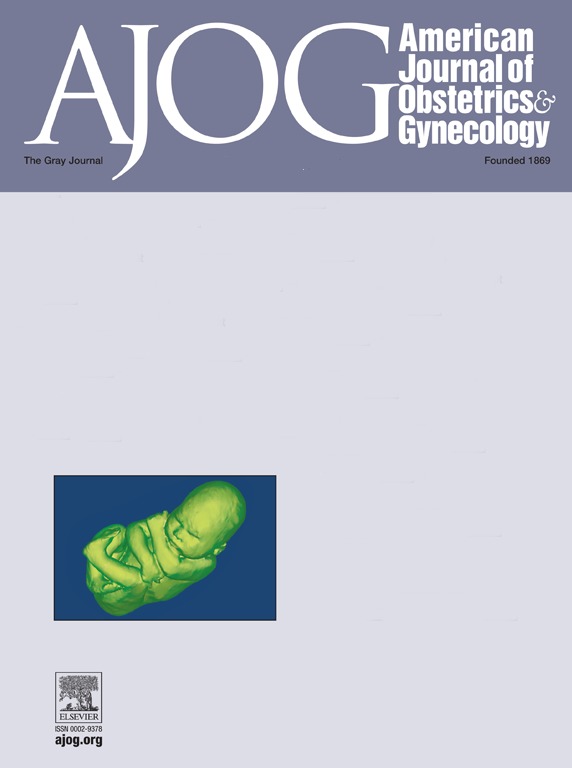Discordance in maximum velocities in the middle cerebral arteries of monochorionic twins: beyond twin-anemia-polycythemia sequence.
IF 8.7
1区 医学
Q1 OBSTETRICS & GYNECOLOGY
引用次数: 0
Abstract
BACKGROUND In monochorionic pregnancies, elevated middle cerebral artery (MCA) peak systolic velocity (PSV) in one twin is a key marker of fetal anemia, notably in TAPS, but may also occur spontaneously in sIUGR, owing to brain-sparing mechanisms or in the context of TTTS particularly following laser therapy. Distinguishing between these etiologies remains challenging, complicating clinical management and counseling. In addition, current MCA-PSV charts are primarily derived from singleton pregnancies, with limited data on monochorionic twins, especially before 18 weeks of gestation. OBJECTIVES The aim of this study was twofold: first, to establish a dedicated MCA-PSV chart for monochorionic twins, and second, to propose a new hemodynamic index (MCA-PSV/UA-PI ratio) for differentiating MCA-PSV changes due to hemodynamic adaptation from fetal anemia. STUDY DESIGN All consecutive monochorionic twin pregnancies referred to our tertiary reference center between January 2019 and December 2023, either for standard follow-up or for a specific complication, were included. This study was conducted in two phases : first, the development of gestational age-specific charts for MCA-PSV and the MCA-PSV/UA-PI ratio using data from uncomplicated pregnancies ; second, the evaluation of the hemodynamic index in pathological conditions associated with elevated MCA-PSV values (sIUGR, spontaneous TAPS, and post-laser follow-up). A Z-score of 2.32 (corresponding to the 99th percentile) was used as the threshold for pathological values. RESULTS Overall, 810 monochorionic twin pregnancies were included. 389 patients with uncomplicated pregnancies were used to generate gestational age-specific charts for both MCA-PSV and MCA-PSV/UA-PI ratio. With a total of 4,021 observations of MCA-PSV, including 640 observations between 14 and 18 weeks of gestation, the estimated mean MCA-PSV before 18 weeks significantly differed from both singleton and twin charts. Differences between observed and smoothed mean MCA-PSV were small (0.49 cm/s, SD ± 0.34). We investigated pathological conditions associated with elevated MCA velocity. Among 67 severe sIUGR cases, 40% presented elevated MCA velocity. Their MCA-PSV/UA-PI ratio was significantly different from spontaneous TAPS (mean MCA-PSV/UA-PI ratio Z-score of 0.60 vs 4.16 for sIUGR and TAPS, respectively, p<0.001): The ratio Z-score was within the normal range for 93% of sIUGR cases and for none of the spontaneous TAPS. Post-laser follow-up showed MCA-PSV elevation in 15/281 TTTS cases (5%), with 9/15 diagnosed as post-laser TAPS. No clear correlation was found between Doppler indices and post-laser TAPS. CONCLUSION This study provides a new gestational age-specific MCA-PSV chart and introduces a novel hemodynamic index (MCA-PSV/UA-PI ratio) that may help differentiate spontaneous anemia from hemodynamic changes and thus, refine both diagnosis and prognosis of complicated monochorionic pregnancies, especially in early gestational ages.单绒毛膜双胞胎大脑中动脉最大流速的不一致:超出双胞胎贫血-红细胞增多症序列。
在单绒毛膜妊娠中,一对双胞胎中大脑中动脉(MCA)峰值收缩速度(PSV)升高是胎儿贫血的关键标志,特别是在TAPS中,但也可能在sIUGR中自发发生,由于脑保留机制或在TTTS背景下,特别是在激光治疗后。区分这些病因仍然具有挑战性,使临床管理和咨询复杂化。此外,目前的MCA-PSV图表主要来自单胎妊娠,单绒毛膜双胞胎的数据有限,特别是在妊娠18周之前。目的本研究的目的有两个:一是建立单绒毛膜双胞胎专用的MCA-PSV图表;二是提出一种新的血液动力学指标(MCA-PSV/UA-PI比值),用于区分血液动力学适应引起的MCA-PSV变化与胎儿贫血。研究设计纳入2019年1月至2023年12月至我们三级参考中心的所有连续单绒毛膜双胎妊娠,无论是标准随访还是特定并发症。本研究分两个阶段进行:首先,利用无并发症妊娠的数据,建立MCA-PSV的妊娠年龄特异性图表和MCA-PSV/UA-PI比值;其次,评估与MCA-PSV值升高相关的病理状态下的血流动力学指标(sIUGR、自发性TAPS和激光后随访)。Z-score为2.32(对应于第99百分位)作为病理值的阈值。结果共纳入810例单绒毛膜双胎妊娠。389例无并发症妊娠患者被用于生成MCA-PSV和MCA-PSV/UA-PI比值的妊娠年龄特异性图表。共有4021例MCA-PSV观察,包括妊娠14至18周的640例观察,18周前估计的平均MCA-PSV与单胎和双胎有显著差异。观察到的平均MCA-PSV与平滑的平均MCA-PSV之间的差异很小(0.49 cm/s, SD±0.34)。我们研究了与MCA速度升高相关的病理情况。在67例重度sIUGR病例中,40%出现MCA速度升高。他们的MCA-PSV/UA-PI比值与自发性tap有显著差异(sIUGR和TAPS的平均MCA-PSV/UA-PI比值Z-score分别为0.60和4.16,p<0.001): 93%的sIUGR病例的比值Z-score在正常范围内,没有自发性tap。激光后随访显示15/281例TTTS患者MCA-PSV升高(5%),其中9/15诊断为激光后TAPS。多普勒指数与激光后TAPS无明显相关性。结论本研究提供了一种新的妊娠年龄特异性MCA-PSV图表,并引入了一种新的血液动力学指标(MCA-PSV/UA-PI比值),该指标有助于区分自发性贫血和血液动力学变化,从而改善复杂单绒毛膜妊娠的诊断和预后,特别是在妊娠早期。
本文章由计算机程序翻译,如有差异,请以英文原文为准。
求助全文
约1分钟内获得全文
求助全文
来源期刊
CiteScore
15.90
自引率
7.10%
发文量
2237
审稿时长
47 days
期刊介绍:
The American Journal of Obstetrics and Gynecology, known as "The Gray Journal," covers the entire spectrum of Obstetrics and Gynecology. It aims to publish original research (clinical and translational), reviews, opinions, video clips, podcasts, and interviews that contribute to understanding health and disease and have the potential to impact the practice of women's healthcare.
Focus Areas:
Diagnosis, Treatment, Prediction, and Prevention: The journal focuses on research related to the diagnosis, treatment, prediction, and prevention of obstetrical and gynecological disorders.
Biology of Reproduction: AJOG publishes work on the biology of reproduction, including studies on reproductive physiology and mechanisms of obstetrical and gynecological diseases.
Content Types:
Original Research: Clinical and translational research articles.
Reviews: Comprehensive reviews providing insights into various aspects of obstetrics and gynecology.
Opinions: Perspectives and opinions on important topics in the field.
Multimedia Content: Video clips, podcasts, and interviews.
Peer Review Process:
All submissions undergo a rigorous peer review process to ensure quality and relevance to the field of obstetrics and gynecology.

 求助内容:
求助内容: 应助结果提醒方式:
应助结果提醒方式:


